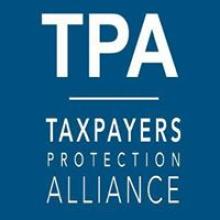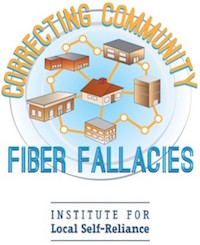
Fast, affordable Internet access for all.

Vinton, Iowa, is on the road to Internet access self-reliance as the community of about 5,100 people continue to move forward with their Fiber-to-the-Home (FTTH) project. They’ve come under attack, however, from the Taxpayers Protection Alliance (TPA). The group is part of a web of organizations aimed at increasing corporate dominance and corporate concentration of power. TPA sent a letter filled with the usual twisted anti-muni spin, but this time went a step farther. A TPA senior fellow mischaracterized a quote from one of the industry’s most respected experts in order to push their harmful agenda.
Former State Representative Chip Baltimore did not run for re-election last year and now fills his days trying to prevent competition for the large incumbent ISPs. His methods include interfering in local communities’ decisions to improve connectivity. In an attempt to undermine the project and frighten community leaders out of supporting it, Baltimore sent a letter to Vinton Municipal Electric Utility Board Members in February.
The letter included several overused fallacies that permeate TPA literature and in other letters we’ve seen directed to decision makers in other communities. Baltimore also included a quote from Joanne Hovis from CTC Technology & Energy. The quote applied to take rates in another part of the country far away from Vinton.
Farr Technologies, the consultants that performed the feasibility study for Vinton, estimated that iVinton could achieve take rates of 40 percent in the first year and grow to 62 percent within five years. Baltimore tried to use Hovis’s statement, which applied to a different community, to discredit Farr’s estimate. It’s true that these rates appear high, but folks in Vinton have shown that they believe the electric utility can provide better service than incumbents Mediacom or CenturyLink. Farr’s consultants considered the community’s survey results, expressions of dissatisfaction with current incumbents, and the electric utility’s stellar reputation with customers when estimating future take rates.
 In 2015, when the town started to dig deeper into the issue, voters decided 792 to 104 that they wanted to put the municipal electric utility in charge of bringing better Internet access to town.
In 2015, when the town started to dig deeper into the issue, voters decided 792 to 104 that they wanted to put the municipal electric utility in charge of bringing better Internet access to town.
In a shifty attempt to use Hovis’s words to support his motives, Baltimore chose to quote Hovis from a presentation she had made to the Tacoma Utility Board and City Council, where the situation is far different than in Vinton. When Hovis learned that her words had been used out of context, she wrote to Vinton’s electric utility board to correct the misrepresentation:
My comments were based on my experience with markets with robust competition such as that in Tacoma, the community in which I was speaking. In Tacoma, there currently exists residential broadband competition from two very capable and robust networks—a phone company fiber- to-the-home network and a cable company hybrid fiber-coaxial network -- as well as from mobile and fixed broadband providers that satisfy some consumers. Given those particular circumstances, I was cautioning my client regarding projections of high data service take-rates.
This Tacoma-focused analysis was in no way appropriate for generalization to the entirety of the country—or to any other single community. I am not familiar with Vinton and have not analyzed your competitive environment, your demographics, your broadband needs, any market research you have conducted, or any other factor that is a necessary component of evaluating potential take-rates for the feasibility of a new broadband network.
In her letter addressing the misuse of her words, Hovis went on to state that she would not presume to make assumptions or predictions about a community unless she dedicated time and research to their unique situation. Quality consultants such as Hovis, policy researchers, and broadband advocates know that each community is unique.
 The TPA and Baltimore depended on the fact that elected officials don’t always have the specialized knowledge to understand how critical local factors influence the success of a community network.
The TPA and Baltimore depended on the fact that elected officials don’t always have the specialized knowledge to understand how critical local factors influence the success of a community network.
Same Old Playbook
The TPA has tried to influence the decisions surrounding broadband options of many local communities. Their purpose is to preserve monopolies and duopolies of big cable and telecom. They act quickly in order to prevent municipal networks from gaining a foothold.
Each time, TPA and similar organizations echo anti-muni arguments that have been repeatedly discredited. They do it so often and with such fervor, we felt the need to create a repository of information to correct their errors and spread of misinformation. We know that local leaders and grassroots advocates repeatedly face the same anti-muni arguments, so we created a page to help local folks who need to address such misinformation. The resource provides examples of work from organizations like Chip Baltimore and the TPA, how to deal with that misinformation, and how people beat their harmful fallacies.
Check out the Correcting Community Fiber Fallacies page for more.
Handling Slick but Sloppy
The TPA, which is one of the most active anti-muni groups, often attempts to denigrate networks that are effectively serving a community, spurring economic development, and saving public dollars.
In 2016, the TPA set its sights on CFU FiberNet in Cedar Falls, Iowa. The network has served the community of about 41,000 people with Fiber-to-the-Home (FTTH) since 2011 and subscribers appreciate fast, affordable, reliable Internet access from the local utility board. The network has kept the economic development engine humming in this community and has even expanded to offer services to areas beyond city limits. In 2015, President Barak Obama visited the small city to congratulate them on their success.
 In 2016, Cedar Falls made the TPA’s “dirty dozen” list, which the organization described as a collection of “failures,” but was actually a compilation of “whoppers.” From the claim that the network wasn’t complete, to the falsity that other utilities took on debt to deploy the network, to a charge that government officials passed loans between municipal enterprises without taking proper and transparent procedures, report authors (who curiously remain a mystery) load up the report with untruths and mischaracterizations.
In 2016, Cedar Falls made the TPA’s “dirty dozen” list, which the organization described as a collection of “failures,” but was actually a compilation of “whoppers.” From the claim that the network wasn’t complete, to the falsity that other utilities took on debt to deploy the network, to a charge that government officials passed loans between municipal enterprises without taking proper and transparent procedures, report authors (who curiously remain a mystery) load up the report with untruths and mischaracterizations.
The report was so shockingly wrong, officials at CFU FiberNet, who might otherwise ignore such propaganda, felt that it should be addressed. They chose the most grievous of the misleading claims and addressed them one by one to correct the record. Sometimes, you just can’t ignore the loud, obnoxious fly buzzing around your head.
Josh Byrnes, Manager of Osage Municipal Utilities in Iowa, also decided to address falsities from the TPA when Baltimore published an opinion piece in the Mason City Globe Gazette. Byrnes published an opinion of his own, which was covered in Broadband Bytes from Community Broadband Action Network:
"There are significant advantages community-owned utilities have when implementing rural broadband access. Community-owned utilities already have established relationships with their customers and can communicate with them directly and in a timely manner. The employees are the friends and neighbors of the community and serve with a sense of purpose."
As Broadband Bytes pointed out, the TPA has published opinion pieces in local news to oppose the network. The organization claims that Traverse City, Michigan, residents have access to “plenty of broadband” because satellite is available to everyone and because Spectrum cable or DSL are available in much of the community. Whether or not residents can afford overpriced, unreliable service with poor customer service isn’t addressed in the TPA’s opinion piece. As people who have experience with satellite Internet access know, satellite is not broadband.
 In order to educate the Traverse City public about the facts of the project, rather than let them be misled by half-truths from the TPA, the Traverse City Light & Power decided to create a FTTP Broadband Project Q & A resource for the community with correct answers to common questions.
In order to educate the Traverse City public about the facts of the project, rather than let them be misled by half-truths from the TPA, the Traverse City Light & Power decided to create a FTTP Broadband Project Q & A resource for the community with correct answers to common questions.
Faulty and Incomplete Data
As is usually the case, the TPA has become masterful at picking out pieces of data that suit their aims. In their letter to Vinton’s Utility Board, they tried to paint Muscatine, Iowa’s investment in a fiber optic network as a failure because of changes in an interdepartmental loan between the electric and communications utility.
While the electric utility acknowledged approximately 4 percent increase in electric rates, they attribute that to “higher delivered coal costs, higher cost of purchased power, and increased operating expenses,” not a planned upgrade from an existing cable network to fiber. The upgrade to fiber, which increased subscribership and resulted in higher than expected revenues, were positive factors that the TPA chose to ignore. The takeaway here is that there’s more to the picture than the simplistic stick figure drawing that the TPA always offers.
 Likewise, in the letter to Vinton, Baltimore failed to point out that Lake County’s decision to sell their fiber optic infrastructure came after years of fighting efforts by incumbents, such as Mediacom and Frontier that wanted to stop the project. With delays and lawsuits to contend with, thanks to corporate incumbents aiming to stop the project, Lake County achieved a major milestone. The project provided high-quality connectivity needed for the residents and businesses in the far northern reaches of Minnesota over an incredibly large rural area where incumbent ISPs would not invest. Many resorts and businesses that served the people in the area and the tourists who visited struggled after years of neglect by large corporate entities like those represented by the TPA.
Likewise, in the letter to Vinton, Baltimore failed to point out that Lake County’s decision to sell their fiber optic infrastructure came after years of fighting efforts by incumbents, such as Mediacom and Frontier that wanted to stop the project. With delays and lawsuits to contend with, thanks to corporate incumbents aiming to stop the project, Lake County achieved a major milestone. The project provided high-quality connectivity needed for the residents and businesses in the far northern reaches of Minnesota over an incredibly large rural area where incumbent ISPs would not invest. Many resorts and businesses that served the people in the area and the tourists who visited struggled after years of neglect by large corporate entities like those represented by the TPA.
The Data Dilemma
If the TPA can’t twist the facts to suit their message, like they did with Hovis’s information, they either find or create resources that rely on incomplete and inaccurate data. And unlike a research organization that protects its reputation to ensure reports, maps, and other resources are accurate to ensure maximum effectiveness, the TPA just doesn’t care.
There’s no other explanation for their “Broadband Boondoggles” map, which tried to label every municipal network as a “failure,” while muddling their own definition of the word. The TPA sacrificed credibility with the project when they placed Sandy, Oregon, in Utah (in addition to other errors).
Credibility or not, the TPA is exceedingly skilled at spreading alarming letters and polished resources filled with misinformation to local communities and state legislatures. With deep pockets and an intense desire to prevent publicly owned networks from catching on, they’ll continue to buzz about like that annoying fly.
